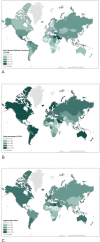Association between urbanisation and type 2 diabetes: an ecological study - PubMed (original) (raw)
Association between urbanisation and type 2 diabetes: an ecological study
Zakariah Gassasse et al. BMJ Glob Health. 2017.
Abstract
Introduction: Previous studies have explored the effect of urbanisation on the prevalence of type 2 diabetes (T2D) at regional/national level. The aim of this study is to investigate the association between urbanisation and T2D at country level, worldwide, and to explore the role of intermediate variables (physical inactivity, sugar consumption and obesity). The potential effect modification of gross domestic product (GDP) was also assessed.
Methods: Data for 207 countries were collected from accessible datasets. Direct acyclic graphs were used to describe the association between urbanisation, T2D and their intermediate variables (physical inactivity, sugar consumption and obesity). Urbanisation was measured as urban percentage (UP) and as agglomeration index (AI). Crude and multivariate linear regression analyses were conducted to explore selected associations. The interaction between urbanisation and T2D across levels of GDP per capita was investigated.
Results: The association between urbanisation and T2D diverged by exposure: AI was positively associated, while UP negatively associated with T2D prevalence. Physical inactivity and obesity were statistically significantly associated with increased prevalence of T2D. In middle-income countries (MIC) UP, AI and GDP were significantly associated with T2D prevalence, while in high-income countries (HIC), physical inactivity and obesity were the main determinant of T2D prevalence.
Conclusions: The type of urban growth, not urbanisation per se, predicted T2D prevalence at country level. In MIC, population density and GDP were the main determinant of diabetes, while in HIC. these were physical inactivity and obesity. Globalisation is playing an important role in the rise of T2D worldwide.
Keywords: descriptive study; environmental health; epidemiology; nutrition; public health.
Figures
Figure 1
A conceptual framework disentangling the reciprocal associations of the variables used in the analysis, using the directed acyclic graph. In orange, the association that were found significant statistically in the multivariate models (table 1). AI, agglomeration index; T2D, type 2 diabetes.
Figure 2
Maps showing the age-adjusted prevalence of T2D as proportion of the total population aged 20–79 years in 2015, worldwide (A); urban proportion, as proportion of total population at country level living in urban areas, worldwide (B); agglomeration index at country levels, worldwide (C). T2D, type 2 diabetes.
Similar articles
- Shifts in population dietary patterns and physical inactivity as determinants of global trends in the prevalence of diabetes: an ecological analysis.
Oggioni C, Lara J, Wells JC, Soroka K, Siervo M. Oggioni C, et al. Nutr Metab Cardiovasc Dis. 2014 Oct;24(10):1105-11. doi: 10.1016/j.numecd.2014.05.005. Epub 2014 May 24. Nutr Metab Cardiovasc Dis. 2014. PMID: 24954422 - Association of Multiple Sclerosis Prevalence With Sociodemographic, Health Systems, and Lifestyle Factors on a National and Regional Level.
Hwang S, Garcia-Dominguez MA, Fitzgerald KC, Saylor DR. Hwang S, et al. Neurology. 2022 Oct 17;99(16):e1813-e1823. doi: 10.1212/WNL.0000000000200962. Neurology. 2022. PMID: 36002320 - Macroenvironmental factors including GDP per capita and physical activity in Europe.
Cameron AJ, Van Stralen MM, Kunst AE, Te Velde SJ, Van Lenthe FJ, Salmon J, Brug J. Cameron AJ, et al. Med Sci Sports Exerc. 2013 Feb;45(2):278-85. doi: 10.1249/MSS.0b013e31826e69f0. Med Sci Sports Exerc. 2013. PMID: 22903137 - Epidemiology of and Risk Factors for Type 2 Diabetes in Egypt.
Hegazi R, El-Gamal M, Abdel-Hady N, Hamdy O. Hegazi R, et al. Ann Glob Health. 2015 Nov-Dec;81(6):814-20. doi: 10.1016/j.aogh.2015.12.011. Ann Glob Health. 2015. PMID: 27108148 Review. - Diabetes Care in Republic of Macedonia: Challenges and Opportunities.
Smokovski I, Milenkovic T, Trapp C, Mitov A. Smokovski I, et al. Ann Glob Health. 2015 Nov-Dec;81(6):792-802. doi: 10.1016/j.aogh.2015.12.017. Ann Glob Health. 2015. PMID: 27108146 Review.
Cited by
- Diabetic microvascular complications among adults with type 2 diabetes in Adama, central Ethiopia.
Negussie YM, Sento M, Fati NM. Negussie YM, et al. Sci Rep. 2024 Oct 22;14(1):24910. doi: 10.1038/s41598-024-77183-2. Sci Rep. 2024. PMID: 39438643 Free PMC article. - Lifestyle and metabolic risk factors, and diabetes mellitus prevalence in European countries from three waves of the European Health Interview Survey.
Kovács N, Shahin B, Andrade CAS, Mahrouseh N, Varga O. Kovács N, et al. Sci Rep. 2024 May 21;14(1):11623. doi: 10.1038/s41598-024-62122-y. Sci Rep. 2024. PMID: 38773149 Free PMC article. - County Rurality and Incidence and Prevalence of Diagnosed Diabetes in the United States.
Dugani SB, Lahr BD, Xie H, Mielke MM, Bailey KR, Vella A. Dugani SB, et al. Mayo Clin Proc. 2024 Jul;99(7):1078-1090. doi: 10.1016/j.mayocp.2023.11.022. Epub 2024 Mar 19. Mayo Clin Proc. 2024. PMID: 38506780 - Estimating the Health Care Expenditure to Manage and Care for Type 2 Diabetes in Nepal: A Patient Perspective.
Dahal PK, Rawal L, Ademi Z, Mahumud RA, Paudel G, Vandelanotte C. Dahal PK, et al. MDM Policy Pract. 2023 Dec 14;8(2):23814683231216938. doi: 10.1177/23814683231216938. eCollection 2023 Jul-Dec. MDM Policy Pract. 2023. PMID: 38107033 Free PMC article. - Area-level deprivation and individual-level socioeconomic correlates of the diabetes care cascade among black south africans in uMgungundlovu, KwaZulu-Natal, South Africa.
Madela SLM, Harriman NW, Sewpaul R, Mbewu AD, Williams DR, Sifunda S, Manyaapelo T, Nyembezi A, Reddy SP. Madela SLM, et al. PLoS One. 2023 Dec 11;18(12):e0293250. doi: 10.1371/journal.pone.0293250. eCollection 2023. PLoS One. 2023. PMID: 38079422 Free PMC article.
References
- Cavan D, Fernandes J, Makaroff L, et al. . Diabetes - atlas: international diabetes federation, 2015.
LinkOut - more resources
Full Text Sources
Other Literature Sources

